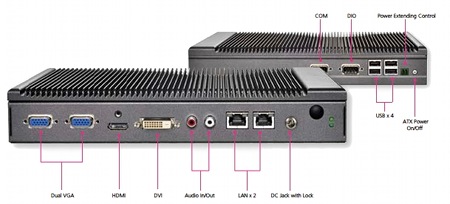Signage PC sports four HD video outputs
Jul 22, 2010 — by LinuxDevices Staff — from the LinuxDevices Archive — 5 viewsLanner announced a compact embedded PC designed for high-definition video applications, sporting an HDMI port, two VGA ports, and a DVI-D port. The LEC-7900D offers two gigabit Ethernet ports, a Type I/II CompactFlash slot, and room for a 2.5-inch hard disk, the company says.
Nvidia's Ion platform has become well-known as a method of adding discrete graphics to Intel Atom-based computers, allowing such devices to provide 1080p HD video playback. Lanner's new LEC-7900D employs Core 2 Duo or Celeron M processors, not Atoms, but it, too, is relying on a combined northbridge/southbridge chip from Nvidia to provide enhanced graphics.
The chip in this case is Nvidia's MCP79A-LP, which was first devised as a way of adding the company's discrete GeForce 9400M graphics to notebook computers, and was later adopted by desktops including Apple's iMac and Mac Mini.
Oddly, Nvidia still does not provide MCP79A-LP information on its website, but the chip reportedly incorporates a DirectX10-capable GPU (graphics processing unit), an HDMI 1.2 interface, support for a 1066 MHz frontside bus, 800MHz DDR2 or 1333MHz DDR3 memory support, SATA/eSATA, a gigabit Ethernet controller, audio, and up to 20 PCI Express 2.0 lanes.
Last year, Lanner released the LEC-7900, which employed a slightly different Nvidia part (the MCP79) and offered a total of three video outputs. These included an HDMI port said to support resolutions up to 1920 x 1080 pixels, plus two VGA ports said to support resolutions up to 1920 x 1080 pixels.
The generally similar LEC-7900D carries over the above ports and adds a fourth: a DVI-D connector that's said to support resolutions up to 1600 x 1200 pixels. According to Lanner, the device can display "two streams of video on two full HD displays," suggesting that not all outputs may be used simultaneously, but no further detail was provided.
Other interfaces (pictured below), no doubt all courtesy of the Nvidia chip, include line output via two RCA jacks, two gigabit Ethernet ports, two COM ports and four USB 2.0 ports, the company says.

Lanner's LEC-7900D
(Click to enlarge)
According to Lanner, the LEC-7900D accepts up to 4GB of memory via two SODIMM slots, and supports Socket P Core 2 Duo or Celeron M CPU (potential clock speeds not stated). The device includes a Type I/II CompactFlash slot, provides room for a 2.5-inch, SATA hard disk drive, and has a Mini PCI Express expansion slot, the company adds.
The LEC-7900D appears to be cooled primarily by its integral heatsink, but Lanner cites a "smart fan" as part of the system. 12VDC input power may be supplied either by an ATX power supply or an external AC adapter, the company adds.
Features and specifications listed by Lanner for its LEC-7900D include the following:
- Processor — Socket P-based Intel Core 2 Duo or Celeron M processors (possible clock speeds not stated)
- Chipset — Nvidia MCP79A-LP
- Memory — Up to 4GB of RAM via 2 SODIMM slots
- Storage — 2.5-inch bay accepts SATA hard disk drives
- Expansion:
- Type I/II CompactFlash slot
- Mini PCIe slot
- Networking — 2 x gigabit Ethernet ports
- Other I/O:
- 2 x VGA
- 1 x HDMI
- 1 x DVI-D
- Line out (2 RCA jacks)
- 2 x RS232
- 4 x USB 2.0
Operating temperature:
- With industrial components, 14 to 131 deg. F (-10 to 55 deg. C)
- With commercial components — 23 to 113 deg. F (-5 to 45 deg. C)
- Power — 12VDC via AC adapter or ATX power supply
- Dimensions — 10.55 x 6.85 x 1.73 inches (268 x 174 x 44mm)
- Operating system support — Linux 2.14.6 and above; Windows XP Embedded, Windows XP
Availability
According to Lanner, the LEC-7900D is sampling now, though pricing was not stated. More information may be found on the company's website, here.
This article was originally published on LinuxDevices.com and has been donated to the open source community by QuinStreet Inc. Please visit LinuxToday.com for up-to-date news and articles about Linux and open source.